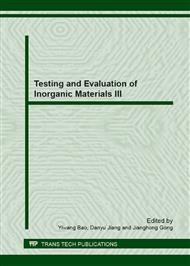[1]
M.W. Barsoum, The MN+1AXN phases: A new class of solids; thermodynamically stable nanolaminates, Prog. Solid. Chem., 28 (2000) 201-281.
DOI: 10.1016/s0079-6786(00)00006-6
Google Scholar
[2]
Y.C. Zhou and Z.M. Sun, Microstructure and mechanism of damage tolerance for Ti3SiC2 bulk ceramics, Mater. Res. Innovat., 2 (1999) 360-363.
Google Scholar
[3]
M.W. Barsoum and T. El-Raghy, Synthesis and characterization of a remarkable ceramic: Ti3SiC2, J. Am. Ceram. Soc., 79 (1996) 1953-(1956).
DOI: 10.1111/j.1151-2916.1996.tb08018.x
Google Scholar
[4]
Y.C. Zhou, Z.M. Sun and B.H. Yu, Microstructure of Ti3SiC2 prepared by the in-situ hot pressing/solid-liquid reaction process, Z. Metallkd., 91.
Google Scholar
[11]
(2000) 937-941.
Google Scholar
[5]
T. El-Raghy, M.W. Barsoum, A. Zavaliangos and S.R. Kalidindi, Processing and mechanical properties of Ti3SiC2: II, Effect of grain size and deformation temperature, J. Am. Ceram. Soc., 82.
DOI: 10.1111/j.1151-2916.1999.tb02167.x
Google Scholar
[10]
(1999) 2855-2860.
Google Scholar
[6]
Z.M. Sun, Y.C. Zhou and M.S. Li, High temperature oxidation behavior of Ti3SiC2-based material in air, Acta Mater., 49.
Google Scholar
[20]
(2001) 4347-4353.
Google Scholar
[7]
D. C. C. Lam, F. F. Lange, and A. G. Evans, Mechanical properties of partially dense alumina produced from powder compacts, J. Am. Ceram. Soc., 77.
Google Scholar
[8]
(2000) 2113-2117.
Google Scholar
[8]
R. F. Cook and G.M. Pharr, Direct observation and analysis of indentation cracking in glasses and ceramics, J. Am. Ceram. Soc. 73 (1990), 787-817.
DOI: 10.1111/j.1151-2916.1990.tb05119.x
Google Scholar
[9]
I.M. Peterson, A. Pajares, B.R. Lawn, V.P. Thompson and E. D. Rekow, Mechanical characterization of dental ceramics by Hertzian contacts, J. Dent. Res. 77 (1998), 589-602.
DOI: 10.1177/00220345980770041201
Google Scholar
[10]
Y.W. Bao H.B. Zhang, and Y.C. Zhou, A simple method for measuring tensile and shear bond strength of ceramic-ceramic and metal-ceramic joining, Mater. Res. Innov., 6 (2002), 277-280.
DOI: 10.1007/s10019-002-0211-5
Google Scholar
[11]
D.T. Wan, Y.W. Bao, et al. Effect of humidity and irradiation aging time on interfacial bonding strength for laminated glass, Chin. Build. Mater. Sci & Tech. 1 (2010), 66-72.
Google Scholar
[12]
Y. Tian, Y.W. Bao, D.T. Wan, et al., Effect of temperature on the interfacial bonding strength between PVB and glass from RT to -50 oC, Key Engin. Mater. 492 (2012), 61-65.
DOI: 10.4028/www.scientific.net/kem.492.61
Google Scholar
[13]
ISO 13124, Fine ceramics (advanced ceramics, advanced technical ceramics) –Test method for interfacial bonding strength of ceramic materials, International Organization for Standards, Geneva, (2011).
DOI: 10.3403/30199643u
Google Scholar
[14]
D.T. Wan, Y.C. Zhou, Y.W. Bao and C.K. Yan, In situ reaction synthesis and characterization of Ti3Si(Al)C2/SiC composites, Ceram. Intern., 32.
DOI: 10.1016/j.ceramint.2005.07.004
Google Scholar
[8]
(2006), 883-889.
Google Scholar


